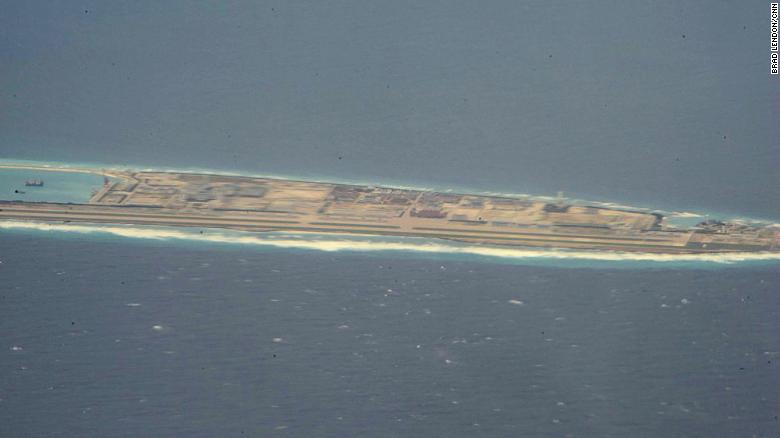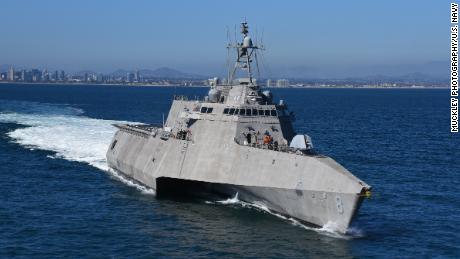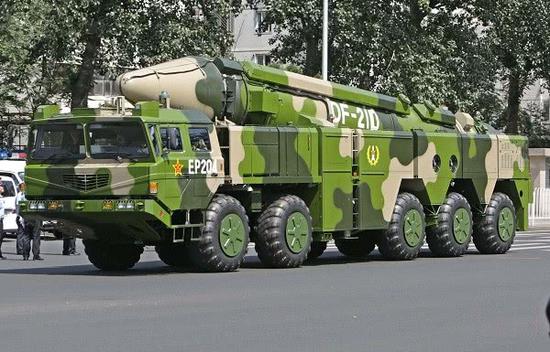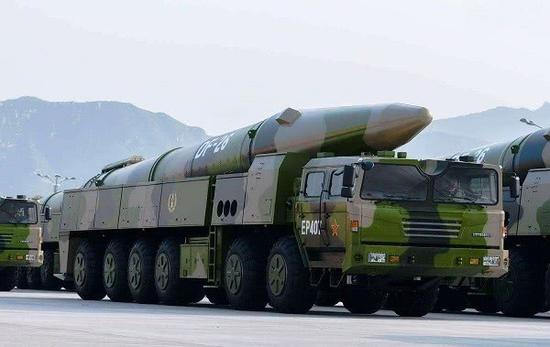- Joined
- Jul 9, 2011
- Messages
- 2,759
- Points
- 48
https://taskandpurpose.com/south-china-missiles
China has reportedly been practicing sinking ships with missiles in the South China Sea
Ryan Pickrell, Business Insider
July 03, 2019 at 09:29 AM
news
Editor's Note: This article originally appeared on Business Insider.
The Chinese military has been practicing sinking enemy vessels with anti-ship naval missiles in the South China Sea, CNBC reported Monday, citing US officials.
The Chinese military reportedly began testing these weapons over the weekend, as a week-long drill kicked off in the disputed waterway. CNBC reports that Chinese forces test-fired anti-ship ballistic missiles (ASBMs), which could include systems like the DF-21D or DF-26.
The testing of ASBMs would be an important first for the South China Sea and a significant step forward as China seeks to strengthen its anti-access, area-denial capabilities, although some expert observers suspect China may have been testing anti-ship cruise missiles.
For ballistic-missile tests, Chinese authorities typically issue Notices to Airmen (NOTAM) identifying "temporary danger areas," Ankit Panda, senior editor at The Diplomat, explained. Such a NOTAM was issued for the period between June 30 and July 1, marking off two locations in the South China Sea.
Beijing previously moved land-based anti-ship cruise missiles (ASCMs), such as the YJ-62 and YJ-12B, to Chinese-occupied territories in the region, a move the US condemned.
"China's militarization of artificial features in the South China Sea includes the deployment of anti-ship missiles, surface-to-air missiles, electronic jammers, and more recently, the landing of bomber aircraft," Jim Mattis, the former secretary of defense, explained last year. "Despite China's claims to the contrary, the placement of these weapons systems is tied directly to military use for the purposes of intimidation and coercion."
Range limits require ASCMs be on islands in the South China Sea in order to reach surrounding waterways. Longer-range ASBMs could be fired from the Chinese mainland, allowing for more robust defenses around the batteries.
China argues that relevant deployments are a necessary response to aggressive US behavior.
China's latest testing comes on the heels of joint drills in the South China Sea involving the USS Ronald Reagan carrier strike group and the Japan Maritime Self-Defense Force's Escort Flotilla 1, which includes the Izumo multi-purpose destroyer that is slated to become Japan's first carrier in decades.
US officials told CNBC that while the US Navy has ships in the South China Sea, the missile testing did not endanger any US ship. The testing was, however, characterized as "concerning."
Locked in competition with great power rivals, the US is looking more closely at the development of anti-ship capabilities as it prepares to counter near-peer threats, such as the massive Chinese navy.
Both the Army and the Marine Corps, for example, are looking at long-range artillery and shore-based anti-ship missile batteries to control the maritime space from land.
"You can imagine a scenario where the Navy feels that it cannot get into the South China Sea because of Chinese naval vessels," Mark Esper, the former secretary of the Army who is now acting secretary of defense, explained earlier this year.
"We can, from a fixed location, on an island or some other place, engage enemy targets, naval targets, at great distances and maintain our standoff and yet open the door, if you will, for naval assets or Marine assets," Esper said.
More from Business Insider:
PoliticsPentagon condemns ‘truly disturbing’ Chinese missile tests in South China Sea
Published Wed, Jul 3 2019 10:27 AM EDTUpdated Wed, Jul 3 2019 1:45 PM EDT
Amanda Macias@amanda_m_macias
Key Points

A Chinese sailor stands guard on the deck of the naval training ship Qi Jiguang during a naval parade to commemorate the 70th anniversary of the founding of China’s PLA Navy in the sea near Qingdao in the eastern China’s Shandong province on April 23, 2019.
Mark Schiefelbein | AFP | Getty Images
WASHINGTON — The Pentagon this week slammed the continued Chinese militarization of the South China Sea on the heels of a CNBC and NBC News report that Beijing was conducting anti-ship ballistic missile tests in the disputed waters.
“Of course the Pentagon was aware of the Chinese missile launch from the man-made structures in the South China Sea near the Spratly Islands,” Pentagon spokesman Lt. Col. Dave Eastburn wrote in an emailed statement in response to a CNBC and NBC News inquiry about the tests.
“What’s truly disturbing about this act is that it’s in direct contradiction to President Xi’s statement in the Rose Garden in 2015 when he pledged to the U.S., the Asia-Pacific region, and the world, that he would not militarize those man-made outposts, ” Eastburn added.
Over the weekend, the Chinese carried out an anti-ship ballistic missile test and fired at least one missile into the South China Sea, according to a U.S. official who spoke on the condition of anonymity in order to discuss the sensitive intelligence. The window for testing remains open until Wednesday, and the official was expecting the Chinese military to test again before it closes.
The development came as the U.S. and China had just paused trade tensions. During the G-20 summit over the weekend in Japan, U.S. President Donald Trump and Chinese President Xi Jinping agreed to restart talks and not impose new tariffs on each other’s goods.
Home to more than 200 specks of land, the South China Sea serves as a gateway to global shipping routes where $3.4 trillion of trade passes annually.
The numerous overlapping sovereign claims to islands, reefs and rocks have turned the waters into an armed camp. Beijing holds the lion’s share of these features with approximately 27 outposts peppered throughout.
“I’m not going to speak on behalf of all the sovereign nations in the region, but I’m sure they agree that [China’s] behavior is contrary to its claim to want to bring peace to the region and obviously actions like this are coercive acts meant to intimidate other South China Sea claimants,” Eastburn said in the emailed statement.

Satellite photo of Fiery Cross Reef in the South China Sea taken on January 1, 2018.
Asia Maritime Transparency Initiative/Center for Strategic and International Studies
In May, CNBC learned that China quietly installed anti-ship cruise missiles and surface-to-air missile systems on three of its fortified outposts west of the Philippines in the sea.
By all accounts, the coastal defense systems represent a significant addition to Beijing’s military portfolio in one of the most contested regions in the world.
According to U.S. intelligence reports, the installations mark the first Chinese missile deployments to Fiery Cross Reef, Subi Reef and Mischief Reef in the Spratly Islands.
The Spratlys, to which six countries lay claim, are located approximately two-thirds of the way east from southern Vietnam to the southern Philippines.
— NBC News correspondent contributed to this report.
https://www.cnbc.com/2019/07/01/chinese-military-conducts-missile-tests-in-the-south-china-sea.html
Chinese military conducts anti-ship ballistic missile tests in the hotly contested South China Sea
Published Mon, Jul 1 2019 5:11 PM EDTUpdated Mon, Jul 1 2019 5:37 PM EDT
Amanda Macias and Courtney Kube
Key Points

Crew members of the Chinese Navy stand guard on the deck of Chinese PLA Navy ship on May 23, 2014.
Soe Than Win | AFP | Getty Images
WASHINGTON — China is in the midst of conducting a series of anti-ship ballistic missile tests in the hotly contested waters of the South China Sea, according to two U.S. officials with knowledge of the matter.
The Chinese carried out the first test over the weekend, firing off at least one missile into the sea, one official said. The window for testing remains open until Wednesday, and the official expects the Chinese military to test again before it closes.
While the U.S. military has ships in the South China Sea, they were not close to the weekend test and are not in danger, the official said. However, the official added that the test is “concerning.” The official, who was not authorized to speak about the testing, could not say whether the anti-ship missiles being tested represent a new capability for the Chinese military.
The Pentagon did not immediately respond to CNBC and NBC’s requests for comment.
The development comes as the U.S. and China have paused tensions in their ongoing trade battle. U.S. President Donald Trump and Chinese President Xi Jinping agreed over the weekend at the G-20 summit in Japan to restart negotiations and not impose new tariffs on each other’s goods. A burgeoning trade deal between the two countries fell through in the beginning of May.
The South China Sea, which is home to more than 200 specks of land, serves as a gateway to global sea routes where approximately $3.4 trillion of trade passes annually.
The numerous overlapping sovereign claims to islands, reefs and rocks — many of which disappear under high tide — have turned the waters into an armed camp. Beijing holds the lion’s share of these features with approximately 27 outposts peppered throughout.
In May 2018, China quietly installed anti-ship cruise missiles and surface-to-air missile systems on three of its fortified outposts west of the Philippines in the South China Sea, a move that allows Beijing to further project its power in the hotly disputed waters, according to sources with direct knowledge of U.S. intelligence reports.
According to U.S. intelligence reports, the installations mark the first Chinese missile deployments to Fiery Cross Reef, Subi Reef and Mischief Reef in the Spratly Islands. The Spratlys, to which six countries lay claim, are located approximately two-thirds of the way east from southern Vietnam to the southern Philippines.
By all accounts, the coastal defense systems represent a significant addition to Beijing’s military portfolio in one of the most contested regions in the world.
The U.S. has remained neutral – but expressed concern – about the overlapping sovereignty claims to the Spratlys.
Still, the U.S. and China have disagreed over several issues regarding the South China Sea.
“China does need to have necessary defense of these islands and rocks, which we believe are Chinese territory,” high-ranking Chinese Col. Zhou Bo told CNBC in June. His remarks came after then-acting U.S. Defense Secretary Patrick Shanahan said America would no longer “tiptoe” around Chinese behavior in the region.
Amanda Macias covers the Pentagon for CNBC. Courtney Kube is an NBC News correspondent covering national security and the Pentagon.
https://www.janes.com/article/89669/china-fires-anti-ship-missile-in-south-china-sea
Naval Weapons
China fires anti-ship missile in South China Sea
Andrew Tate, London and Ashley Roque, Washington DC - Jane's Defence Weekly
03 July 2019
Follow
RSS
China has conducted an anti-ship missile test-firing in the South China Sea, a US Department of Defense (DoD) spokesperson told Jane's in a 2 July statement, confirming parts of an NBC News report published a day earlier stating that the firing had taken place on 30 June.
The spokesperson, who described the event as "disturbing", said that a missile had been launched from one of China's "man-made structures in the South China Sea near the Spratly Islands".
A CNBC report claimed that the weapon fired was an anti-ship ballistic missile, citing "two US officials with knowledge of the matter". This, however, was not confirmed by the Pentagon, but neither was it dismissed.
Want to read more? For analysis on this article and access to all our insight content, please enquire about our subscription options at ihsmarkit.com/janes
China has reportedly been practicing sinking ships with missiles in the South China Sea
Ryan Pickrell, Business Insider
July 03, 2019 at 09:29 AM
news
Editor's Note: This article originally appeared on Business Insider.
The Chinese military has been practicing sinking enemy vessels with anti-ship naval missiles in the South China Sea, CNBC reported Monday, citing US officials.
The Chinese military reportedly began testing these weapons over the weekend, as a week-long drill kicked off in the disputed waterway. CNBC reports that Chinese forces test-fired anti-ship ballistic missiles (ASBMs), which could include systems like the DF-21D or DF-26.
The testing of ASBMs would be an important first for the South China Sea and a significant step forward as China seeks to strengthen its anti-access, area-denial capabilities, although some expert observers suspect China may have been testing anti-ship cruise missiles.
For ballistic-missile tests, Chinese authorities typically issue Notices to Airmen (NOTAM) identifying "temporary danger areas," Ankit Panda, senior editor at The Diplomat, explained. Such a NOTAM was issued for the period between June 30 and July 1, marking off two locations in the South China Sea.
Beijing previously moved land-based anti-ship cruise missiles (ASCMs), such as the YJ-62 and YJ-12B, to Chinese-occupied territories in the region, a move the US condemned.
"China's militarization of artificial features in the South China Sea includes the deployment of anti-ship missiles, surface-to-air missiles, electronic jammers, and more recently, the landing of bomber aircraft," Jim Mattis, the former secretary of defense, explained last year. "Despite China's claims to the contrary, the placement of these weapons systems is tied directly to military use for the purposes of intimidation and coercion."
Range limits require ASCMs be on islands in the South China Sea in order to reach surrounding waterways. Longer-range ASBMs could be fired from the Chinese mainland, allowing for more robust defenses around the batteries.
China argues that relevant deployments are a necessary response to aggressive US behavior.
China's latest testing comes on the heels of joint drills in the South China Sea involving the USS Ronald Reagan carrier strike group and the Japan Maritime Self-Defense Force's Escort Flotilla 1, which includes the Izumo multi-purpose destroyer that is slated to become Japan's first carrier in decades.
US officials told CNBC that while the US Navy has ships in the South China Sea, the missile testing did not endanger any US ship. The testing was, however, characterized as "concerning."
Locked in competition with great power rivals, the US is looking more closely at the development of anti-ship capabilities as it prepares to counter near-peer threats, such as the massive Chinese navy.
Both the Army and the Marine Corps, for example, are looking at long-range artillery and shore-based anti-ship missile batteries to control the maritime space from land.
"You can imagine a scenario where the Navy feels that it cannot get into the South China Sea because of Chinese naval vessels," Mark Esper, the former secretary of the Army who is now acting secretary of defense, explained earlier this year.
"We can, from a fixed location, on an island or some other place, engage enemy targets, naval targets, at great distances and maintain our standoff and yet open the door, if you will, for naval assets or Marine assets," Esper said.
More from Business Insider:
- A professional drifter explains the physics behind drifting
- Here are the best updates coming to your iPhone this fall
- There's a scientific reason men get beer bellies and women don't
PoliticsPentagon condemns ‘truly disturbing’ Chinese missile tests in South China Sea
Published Wed, Jul 3 2019 10:27 AM EDTUpdated Wed, Jul 3 2019 1:45 PM EDT
Amanda Macias@amanda_m_macias
Key Points
- The Pentagon called the continued Chinese militarization of the South China Sea “truly disturbing” on the heels of a CNBC and NBC News report.
- Over the weekend, the Chinese carried out an anti-ship ballistic missile test and fired at least one missile into the South China Sea.
- Home to more than 200 specks of land, the South China Sea serves as a gateway to global shipping routes where $3.4 trillion of trade passes annually.

A Chinese sailor stands guard on the deck of the naval training ship Qi Jiguang during a naval parade to commemorate the 70th anniversary of the founding of China’s PLA Navy in the sea near Qingdao in the eastern China’s Shandong province on April 23, 2019.
Mark Schiefelbein | AFP | Getty Images
WASHINGTON — The Pentagon this week slammed the continued Chinese militarization of the South China Sea on the heels of a CNBC and NBC News report that Beijing was conducting anti-ship ballistic missile tests in the disputed waters.
“Of course the Pentagon was aware of the Chinese missile launch from the man-made structures in the South China Sea near the Spratly Islands,” Pentagon spokesman Lt. Col. Dave Eastburn wrote in an emailed statement in response to a CNBC and NBC News inquiry about the tests.
“What’s truly disturbing about this act is that it’s in direct contradiction to President Xi’s statement in the Rose Garden in 2015 when he pledged to the U.S., the Asia-Pacific region, and the world, that he would not militarize those man-made outposts, ” Eastburn added.
Over the weekend, the Chinese carried out an anti-ship ballistic missile test and fired at least one missile into the South China Sea, according to a U.S. official who spoke on the condition of anonymity in order to discuss the sensitive intelligence. The window for testing remains open until Wednesday, and the official was expecting the Chinese military to test again before it closes.
The development came as the U.S. and China had just paused trade tensions. During the G-20 summit over the weekend in Japan, U.S. President Donald Trump and Chinese President Xi Jinping agreed to restart talks and not impose new tariffs on each other’s goods.
Home to more than 200 specks of land, the South China Sea serves as a gateway to global shipping routes where $3.4 trillion of trade passes annually.
The numerous overlapping sovereign claims to islands, reefs and rocks have turned the waters into an armed camp. Beijing holds the lion’s share of these features with approximately 27 outposts peppered throughout.
“I’m not going to speak on behalf of all the sovereign nations in the region, but I’m sure they agree that [China’s] behavior is contrary to its claim to want to bring peace to the region and obviously actions like this are coercive acts meant to intimidate other South China Sea claimants,” Eastburn said in the emailed statement.

Satellite photo of Fiery Cross Reef in the South China Sea taken on January 1, 2018.
Asia Maritime Transparency Initiative/Center for Strategic and International Studies
In May, CNBC learned that China quietly installed anti-ship cruise missiles and surface-to-air missile systems on three of its fortified outposts west of the Philippines in the sea.
By all accounts, the coastal defense systems represent a significant addition to Beijing’s military portfolio in one of the most contested regions in the world.
According to U.S. intelligence reports, the installations mark the first Chinese missile deployments to Fiery Cross Reef, Subi Reef and Mischief Reef in the Spratly Islands.
The Spratlys, to which six countries lay claim, are located approximately two-thirds of the way east from southern Vietnam to the southern Philippines.
— NBC News correspondent contributed to this report.
https://www.cnbc.com/2019/07/01/chinese-military-conducts-missile-tests-in-the-south-china-sea.html
Chinese military conducts anti-ship ballistic missile tests in the hotly contested South China Sea
Published Mon, Jul 1 2019 5:11 PM EDTUpdated Mon, Jul 1 2019 5:37 PM EDT
Amanda Macias and Courtney Kube
Key Points
- China is in the midst of conducting a series of anti-ship ballistic missile tests in the hotly contested waters of the South China Sea, according to two U.S. officials with knowledge of the matter.
- The development comes as the U.S. and China have paused tensions in their ongoing trade battle.
- The South China Sea, which is home to more than 200 specks of land, serves as a gateway to global sea routes where approximately $3.4 trillion of trade passes annually.

Crew members of the Chinese Navy stand guard on the deck of Chinese PLA Navy ship on May 23, 2014.
Soe Than Win | AFP | Getty Images
WASHINGTON — China is in the midst of conducting a series of anti-ship ballistic missile tests in the hotly contested waters of the South China Sea, according to two U.S. officials with knowledge of the matter.
The Chinese carried out the first test over the weekend, firing off at least one missile into the sea, one official said. The window for testing remains open until Wednesday, and the official expects the Chinese military to test again before it closes.
While the U.S. military has ships in the South China Sea, they were not close to the weekend test and are not in danger, the official said. However, the official added that the test is “concerning.” The official, who was not authorized to speak about the testing, could not say whether the anti-ship missiles being tested represent a new capability for the Chinese military.
The Pentagon did not immediately respond to CNBC and NBC’s requests for comment.
The development comes as the U.S. and China have paused tensions in their ongoing trade battle. U.S. President Donald Trump and Chinese President Xi Jinping agreed over the weekend at the G-20 summit in Japan to restart negotiations and not impose new tariffs on each other’s goods. A burgeoning trade deal between the two countries fell through in the beginning of May.
The South China Sea, which is home to more than 200 specks of land, serves as a gateway to global sea routes where approximately $3.4 trillion of trade passes annually.
The numerous overlapping sovereign claims to islands, reefs and rocks — many of which disappear under high tide — have turned the waters into an armed camp. Beijing holds the lion’s share of these features with approximately 27 outposts peppered throughout.
In May 2018, China quietly installed anti-ship cruise missiles and surface-to-air missile systems on three of its fortified outposts west of the Philippines in the South China Sea, a move that allows Beijing to further project its power in the hotly disputed waters, according to sources with direct knowledge of U.S. intelligence reports.
According to U.S. intelligence reports, the installations mark the first Chinese missile deployments to Fiery Cross Reef, Subi Reef and Mischief Reef in the Spratly Islands. The Spratlys, to which six countries lay claim, are located approximately two-thirds of the way east from southern Vietnam to the southern Philippines.
By all accounts, the coastal defense systems represent a significant addition to Beijing’s military portfolio in one of the most contested regions in the world.
The U.S. has remained neutral – but expressed concern – about the overlapping sovereignty claims to the Spratlys.
Still, the U.S. and China have disagreed over several issues regarding the South China Sea.
“China does need to have necessary defense of these islands and rocks, which we believe are Chinese territory,” high-ranking Chinese Col. Zhou Bo told CNBC in June. His remarks came after then-acting U.S. Defense Secretary Patrick Shanahan said America would no longer “tiptoe” around Chinese behavior in the region.
Amanda Macias covers the Pentagon for CNBC. Courtney Kube is an NBC News correspondent covering national security and the Pentagon.
https://www.janes.com/article/89669/china-fires-anti-ship-missile-in-south-china-sea
Naval Weapons
China fires anti-ship missile in South China Sea
Andrew Tate, London and Ashley Roque, Washington DC - Jane's Defence Weekly
03 July 2019
Follow
RSS
China has conducted an anti-ship missile test-firing in the South China Sea, a US Department of Defense (DoD) spokesperson told Jane's in a 2 July statement, confirming parts of an NBC News report published a day earlier stating that the firing had taken place on 30 June.
The spokesperson, who described the event as "disturbing", said that a missile had been launched from one of China's "man-made structures in the South China Sea near the Spratly Islands".
A CNBC report claimed that the weapon fired was an anti-ship ballistic missile, citing "two US officials with knowledge of the matter". This, however, was not confirmed by the Pentagon, but neither was it dismissed.
Want to read more? For analysis on this article and access to all our insight content, please enquire about our subscription options at ihsmarkit.com/janes










